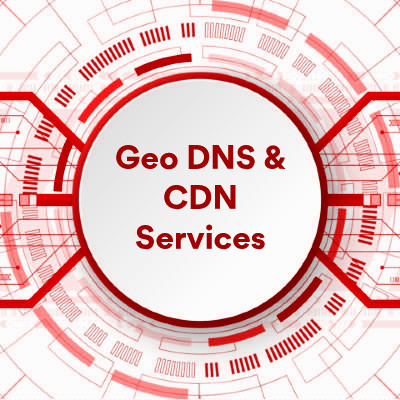


Geo DNS and CDN Services
Geo DNS stands for Geographical Domain Name System. It is a DNS-based service that routes users to different servers or IP addresses based on their geographical location. Geo DNS helps optimise website performance, improve load times, and distribute traffic by directing users to the nearest or most appropriate server. It is often used with CDNs for global content delivery.
CDN stands for Content Delivery Network. It is a network of servers distributed worldwide that efficiently delivers content to users, such as websites, videos, and other digital assets. CDNs reduce latency, improve load times, and enhance overall user experience by caching content closer to the end-users.
Geographical Domain Name System (Geo DNS) – Improve service performance
Geo DNS is used to increase the performance of your website, API, etc.
Firstly, you would place your website data servers in locations that give your customers the best performance. For example, if your customers are UK and Chinese, the best places for your internet data would be the UK and China.
A Geo DNS would send (route) your customer to the best data server location, giving them the fastest response times.
Continuing the example above, you may program the Geo DNS to send all traffic originating from Asia to China data servers and the rest of the world traffic to the UK data server.
A task should run between the data servers in the background, keeping the data between the servers in syndication.
In summary, a Geo DNS performs;
- Geolocation Data - When a user requests access to a domain, their IP address is used to determine their geographic location. This is achieved through IP geolocation databases or services.
- DNS Resolution - Based on the user's geographic location, the DNS server selects the most suitable IP address or server from a pool of options. This selection is made according to predefined rules set by the domain owner.
- DNS Response- The DNS server responds to the user's request with an IP address corresponding to the server or data centre closest to their location. This minimises latency and improves load times.
- Content Delivery- The user is directed to the chosen server or data centre serving the requested content.
Geographical Domain Name System (Geo DNS) – sending a customer to a different domain.
International, sending a customer to a local/regional service is often required. For example, banks operate according to rules and regulations within the country; therefore, a customer needs to be sent to the country's website, not an international one. This is often the case for local purchasing from e-commerce sites.
Standard Geo DNS can only change the IP address so that you will require a middle step to the Domain routing. The middle step will change the domain / URL to a different service. This is straightforward and should be performed on the local country server, known as “website forwarding.”
The issue is that customers travelling to a different country cannot be connected to their country service as they will always be connected to the local country service.
Benefits of GeoDNS
- Improved Performance - By directing users to the nearest or most appropriate server, GeoDNS reduces latency and improves load times.
- Load Balancing - Distributes traffic among multiple servers or data centres, balancing the load and preventing any single server from becoming overwhelmed.
- Disaster Recovery - Provides redundancy by directing users to alternative servers if the primary server fails or needs maintenance.
- Compliance and Localization - This feature helps comply with regional regulations by directing traffic to servers that meet local data residency requirements. It can also provide localised content based on the user's region.
Content Delivery Network (CDN) services
CDN services bring together a Geo DNS and locally stored information close to the customer's location.
This is one way Cloud Service works. You load your information to a centre server/location. The cloud service should keep a backup copy across data centres and distribute your data to where it is most used.
The CDN servers typically use this for Multimedia content, video, images, etc., which are larger files and take longer to transmit across the Internet. Storing these types of files locally to customers dramatically improves the performance of your services.
This works successfully in many parts of the world. This is not the case for China.
The CDN service uses its domain name for your CDN data. For example, your domain, “Fred.com,” is the same, but the CDN service, e.g., “Bill,” uses its domain name for your data: Bill.com. All Bill CDN data worldwide use their domain name.
If the Chinese authorities find images/files in the Bill.com CDN system that break the publishing rules in China, they can block the CDN data from China. Usually, like with Google files, they limit the amount of data that can enter China, significantly slowing down the CDN service.
If a CDN service is using your domain, in the above example “Fred.com”, this would not be an issue as the Chinese authorities publishing rules by domain will not be an issue; they can monitor each site independently.
In summary, many Content Delivery Networks (CDNs) use GeoDNS as part of their system to optimise content delivery. Here's how CDNs and GeoDNS work together:
- Geographic Routing - CDNs have multiple servers or nodes distributed across different locations. When a user requests content, GeoDNS can route the request to the nearest CDN node based on the user's geographic location.
- Improved Performance - Directing users to the closest CDN node reduces latency, and the content loads faster. This is because the data does not have to travel as far and leverages the CDN's infrastructure to deliver content efficiently.
- Load Balancing - GeoDNS helps distribute traffic among various CDN nodes. If one node is experiencing high traffic or is under maintenance, GeoDNS can redirect traffic to another nearby node.
- Content Caching - CDNs cache content at various edge locations. GeoDNS ensures that users are served content from the cache closest to them, improving load times and reducing the load on the origin server.
- Redundancy and Reliability - CDNs can provide redundancy by using GeoDNS. If one node is down or experiencing issues, traffic can be automatically redirected to other healthy nodes.
Last modified: V2.2 - 18 September 2024











